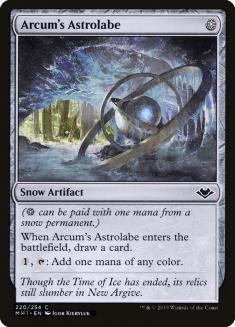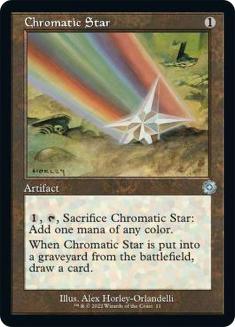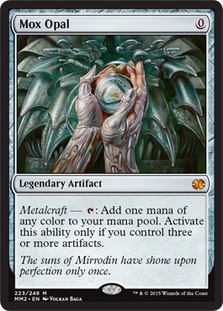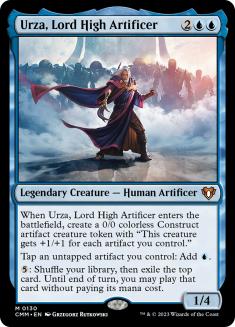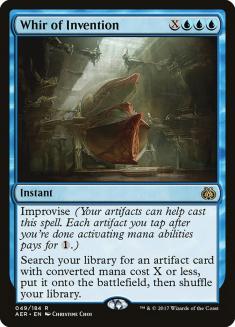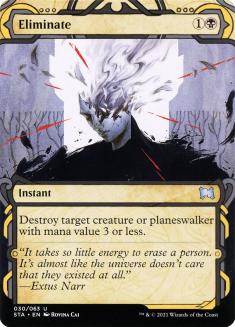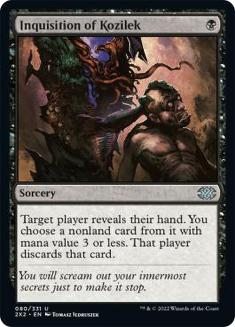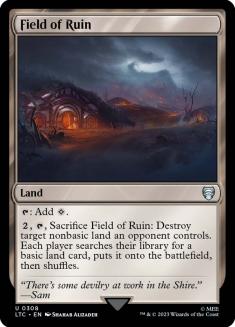Artifacts in Modern have been overpowered since the start of the format. Even with multiple bannings targeting those archetypes, the iron machine continues to fight forward and remain a dominant force. Mox Opal and Krark-Clan Ironworks were removed from competitive play not too long ago and decks built around the power of artifacts still rose to the top. Even with these two cards removed, another artifact had to go to restore a forgotten shard of the metagame.
Arcum’s Astrolabe was one of the most oppressive cards that most folks never noticed. It is humble in nature, as a small cantrip with some mana fixing is typically not a card that people grab the pitchforks against.
I wrote an article that called for its head months ago and explained the repressive nature that this card had on both Modern and Legacy. Entire aggressive archetypes were wiped out because the midrange and control decks could cast every colored spell in their spellbook with near-immunity.
Blood Moon and the damage from shocklands were enough of a wall to stop this from happening; however, each of the decks that would be weak to those safeguards switched to an all snow-basic strategy. This created a dull format, limiting the viable aggro decks, and making future set design a more difficult task than it needed to be.
There was more to my attack on Arcum’s Astrolabe, a card that I played in every competitive format it was legal in, but that is not what this article is about. The artifact deckbuilding process took another massive hit and was not even in the crosshairs for this banning.
The collateral damage to the artifact-based archetypes, Urza, Lord High Artificer especially, was huge. I have been big on Grinding Breach in Modern these last few months and the removal of Arcum’s Astrolabe has made the deck significantly weaker. Not only did the deck need that early cantripping power to hit land drops and combo pieces, it needed four colors, breaking the color wheel to achieve its combo with maximum strength.
Arcum’s Astrolabe has no direct replacement, but it does have a slightly weaker card that may get the job done.
Creatures (10)
Planeswalkers (4)
Lands (15)
Spells (31)

This deck is not dead in the water, thanks to Chromatic Star and Chromatic Sphere. These two artifacts allowed Ironworks to play several multicolored spells while having a land base only capable of casting Gruul spells. Chromatic Star will never be Arcum’s Astrolabe, as it requires another mana to cantrip and only fixes the mana one time. The weakness here is obvious, but it is good enough to keep a deck like this competitive.
Grinding Breach plays out a bit differently now and that’s to be expected. Emry, Lurker of the Loch has a bit more upside with Chromatic Star, adding to Mishra’s Bauble as a repeatable source of cantripping. This new avenue is also used by Lurrus of the Dream-Den, as it feasts on cheap, artifact cantrips like these.
Chromatic Star will typically be your vessel to cast Teferi, Time Raveler and Lurrus of the Dream-Den, as the manabase is not friendly to white cards. Without Arcum’s Astrolabe, there is an argument to drop down to fewer colors, but that would cut these two powerful allies out of the mix.
Both threats are game-ending if left on the battlefield. Teferi prevents any interaction with your combo as you go off and returns a problematic permanent to the opponent’s hand to buy time. This effect is too important to give up and must be present for this to remain one of the best combo decks out there.
Lurrus is another deadly permanent when left unchecked. It provides repeated card advantage, like Emry, Lord of the Loch, but also can buy back a lost Underworld Breach. Having this many powerful options from the white splash makes the inclusion less of a debate. Our focus should be on making the third color work, to maximize the powerful elements that this deck has to offer.
Before my inclusion of Lurrus, I took down an SCG Regionals with a four-color version of Grinding Breach. Having that fourth color was a stretch then with Arcum’s Astrolabe but is out of the picture now. Having Thoughtseize was fantastic, allowing me to push through combo pieces with limited resistance; however, the cost is now too high. One-mana black disruption doesn’t work on the back of Chromatic Star and the deck will have to work with the Jeskai colors alone.
This combo deck survives the banning of Arcum’s Astrolabe and is still a top contender today in Modern. At this point in the format, artifact removal and interaction is at an all-time low. Without Mox Opal, we already saw a stark decline in disruption against artifacts. Once Arcum’s Astrolabe was added to the hit-list, players were quickly dropping their Collector Ouphes out of their sideboards. When these combo decks have limited hate against them, watch out. This is still a Turn 3 kill when it’s not disrupted, or easily taking over the game by Turn 4 after a Teferi or Lurrus hits the battlefield.
Urza is not the captain of Grinding Breach but plays a pivotal role in the late-game. When the combo does not work out and the disruption is too high, the blue legendary creature takes over the game. Urza is a one-card combo, producing a big threat, a ton of mana, and an ability that cranks out free spells. Grinding Breach does not extract the best value out of this creature but does use it as a separate angle of victory when things do not go well at the start.
Arcum’s Astrolabe leaving the format dealt the biggest blow to Urza, but just like Grinding Breach, it is still too powerful to die off.
Creatures (4)
Lands (19)
Spells (37)

The best control deck in Modern was Dimir Whirza before but is Azorius Control by a decent margin now. I wrote about a few Modern control options last week and I left out Dimir Whirza because I was not able to try it out until a few days ago. The Arcum’s Astrolabe was swapped out for Chromatic Star, as well as a few other slight modifications, and the deck still can operate. This is where Arcum’s Astrolabe is missed the most, because of the mana hit to Urza and Whir of Invention.
Both blue spells depend on artifacts that remain on the battlefield, which is why Arcum’s Astrolabe was so good in this deck. The mana fixing was completely ignored in Dimir Whirza, as this two-color deck can easily cast all its spells without artifact assistance.
The mana fixing may have been worthless, but the immediate card and artifact presence on the battlefield has been sorely missed. Chromatic Star completes exactly one half of that equation. Either you can replace it for another card or keep it on the battlefield to produce mana for Urza or Whir of Invention.
Since the option is there, like Mishra’s Bauble, Dimir Whirza was not erased by the banning of Arcum’s Astrolabe. In the games I played, it was more difficult to seamlessly regain battlefield control than for combo, but not difficult enough to produce losses.

Most scenarios that were more difficult centered around the Construct token and the lost power and toughness. Typically when I was left to do combat math, the game was getting tighter. In these spots, I often needed to find additional answers, tossing my Chromatic Star aside to do so, making my Construct tokens weaker in the process. The difference between a 4/4 and a 5/5 is huge in Modern, so further testing will have to take place to determine whether the deck significantly suffers in the grindier matchups.
The other modifications to Dimir Whirza were to address the current, more aggressive Modern that now exists after the Arcum’s Astrolabe banning. The Uro decks have thinned out, and the Mono-Red Aggro decks are on the rise. I have seen even seen a resurgence in Humans, as the broken midrange decks have now exited the format.
This bodes well for Dimir Whirza, which has a built-in combo that feasts on aggressive decks. The copies of Fatal Push were increased to four, and Eliminate was added to further push Dimir Whirza ahead of the incoming aggro wave.
Dimir Whirza also has a solid game against control, utilizing the top blue and black disruption the format has to offer. The Mystic Sanctuary / Cryptic Command combo is here yet again, joined by Archmage’s Charm and Drown in the Loch for maximum countermagic power. This blue disruption is good against creatures also, making the maindeck a solid Game 1 against most of the field.
Thoughtseize and Inquisition of Kozilek are still split, due to the uncertainty of a new format. Even though aggro decks got a boost, Inquisition of Kozilek misses some big hitters from the Urzatron decks and needs to share time with Thoughtseize.
In addition to the Thoughtseize use, the copies of Field of Ruin went from two to four to answer big mana strategies. Running two copies of Field of Ruin is too much of a liability in a world full of Mono-Green Tron and Eldrazi Tron decks, especially in a two-color deck. These changes, plus the inclusion of Chromatic Star, have kept Dimir Whirza as one of my top choices for Modern moving forward.
At this point, I can confidently say that banning Arcum’s Astrolabe is not a big enough loss to push Urza, Lord High Artificer into the trade binder. The card is too powerful as a brute-force win condition and as a mana engine to not be a top-tier contender in Modern.
There will be more artifacts that fuel decks like these, which is one of the main reasons why the bannings targeted the enablers. When the enablers, like Mox Opal and Arcum’s Astrolabe, are too good, play design must stymie its creativity when making payoff cards.
Urza is a wonderfully designed card and incentivizes R&D to make more sweet artifacts. With sets drafted well in advance, I expect to see more fuel heading to Urza soon. Without Mox Opal and Arcum’s Astrolabe around, this will be at a smaller risk to the health of the format and future bannings.
Both artifact decks in Modern were negatively impacted by the loss of Arcum’s Astrolabe. Luckily for us who love these types of decks, each option is still a viable choice for competitive play in Modern. Chromatic Star has done what we need it to do: make artifacts playable in both a control and combo setting.
I miss Arcum’s Astrolabe with my Urza, but I still feel that surge of power when resolving it on Turn 3 or Turn 4. The mana source, the Construct, and the cards off the top of the library are good enough, even without Arcum’s Astrolabe, to keep these decks competitive.


